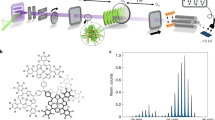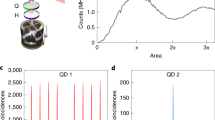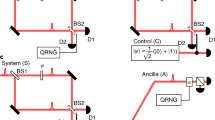Abstract
The quantum superposition principle allows massive particles to be delocalized over distant positions. Though quantum mechanics has proved adept at describing the microscopic world, quantum superposition runs counter to intuitive conceptions of reality and locality when extended to the macroscopic scale1, as exemplified by the thought experiment of Schrödinger’s cat2. Matter-wave interferometers3, which split and recombine wave packets in order to observe interference, provide a way to probe the superposition principle on macroscopic scales4 and explore the transition to classical physics5. In such experiments, large wave-packet separation is impeded by the need for long interaction times and large momentum beam splitters, which cause susceptibility to dephasing and decoherence1. Here we use light-pulse atom interferometry6,7 to realize quantum interference with wave packets separated by up to 54 centimetres on a timescale of 1 second. These results push quantum superposition into a new macroscopic regime, demonstrating that quantum superposition remains possible at the distances and timescales of everyday life. The sub-nanokelvin temperatures of the atoms and a compensation of transverse optical forces enable a large separation while maintaining an interference contrast of 28 per cent. In addition to testing the superposition principle in a new regime, large quantum superposition states are vital to exploring gravity with atom interferometers in greater detail. We anticipate that these states could be used to increase sensitivity in tests of the equivalence principle8,9,10,11,12, measure the gravitational Aharonov–Bohm effect13, and eventually detect gravitational waves14 and phase shifts associated with general relativity12.
This is a preview of subscription content, access via your institution
Access options
Subscribe to this journal
Receive 51 print issues and online access
$199.00 per year
only $3.90 per issue
Buy this article
- Purchase on Springer Link
- Instant access to full article PDF
Prices may be subject to local taxes which are calculated during checkout





Similar content being viewed by others
References
Arndt, M. & Hornberger, K. Testing the limits of quantum mechanical superpositions. Nature Phys. 10, 271–277 (2014)
Schrödinger, E. Die gegenwärtige Situation in der Quantenmechanik. Naturwissenschaften 23, 807–812 (1935)
Cronin, A. D., Schmiedmayer, J. & Pritchard, D. E. Optics and interferometry with atoms and molecules. Rev. Mod. Phys. 81, 1051–1129 (2009)
Nimmrichter, S. & Hornberger, K. Macroscopicity of mechanical quantum superposition states. Phys. Rev. Lett. 110, 160403 (2013)
Bassi, A., Lochan, K., Satin, S., Singh, T. & Ulbricht, H. Models of wave-function collapse, underlying theories, and experimental tests. Rev. Mod. Phys. 85, 471–527 (2013)
Bordé, C. J. Atomic interferometry with internal state labelling. Phys. Lett. A 140, 10–12 (1989)
Kasevich, M. & Chu, S. Atomic interferometry using stimulated Raman transitions. Phys. Rev. Lett. 67, 181–184 (1991)
Bonnin, A., Zahzam, N., Bidel, Y. & Bresson, A. Simultaneous dual-species matter-wave accelerometer. Phys. Rev. A 88, 043615 (2013)
Schlippert, D. et al. Quantum test of the universality of free fall. Phys. Rev. Lett. 112, 203002 (2014)
Kuhn, C. C. N. et al. A Bose-condensed, simultaneous dual-species Mach-Zehnder atom interferometer. New J. Phys. 16, 073035 (2014)
Geiger, R. et al. Detecting inertial effects with airborne matter-wave interferometry. Nature Commun. 2, 474 (2011)
Dimopoulos, S., Graham, P., Hogan, J. & Kasevich, M. General relativistic effects in atom interferometry. Phys. Rev. D 78, 042003 (2008)
Hohensee, M. A., Estey, B., Hamilton, P., Zeilinger, A. & Müller, H. Force-free gravitational redshift: proposed gravitational Aharonov-Bohm experiment. Phys. Rev. Lett. 108, 230404 (2012)
Dimopoulos, S., Graham, P., Hogan, J., Kasevich, M. & Rajendran, S. Atomic gravitational wave interferometric sensor. Phys. Rev. D 78, 122002 (2008)
Julsgaard, B., Kozhekin, A. & Polzik, E. S. Experimental long-lived entanglement of two macroscopic objects. Nature 413, 400–403 (2001)
Aspect, A., Dalibard, J. & Roger, G. Experimental test of Bell’s inequalities using time-varying analyzers. Phys. Rev. Lett. 49, 1804–1807 (1982)
Giustina, M. et al. Bell violation using entangled photons without the fair-sampling assumption. Nature 497, 227–230 (2013)
Jacques, V. et al. Experimental realization of Wheeler’s delayed-choice gedanken experiment. Science 315, 966–968 (2007)
Manning, A. G., Khakimov, R. I., Dall, R. G. & Truscott, A. G. Wheeler’s delayed-choice gedanken experiment with a single atom. Nature Phys. 11, 539–542 (2015)
Bordé, C. J. et al. Observation of optical Ramsey fringes in the 10 μm spectral region using a supersonic beam of SF6 . J. Phys. (Paris) 42(C8), 15–19 (1981)
Keith, D. W., Ekstrom, C. R., Turchette, Q. A. & Pritchard, D. E. An interferometer for atoms. Phys. Rev. Lett. 66, 2693–2696 (1991)
Müller, H., Chiow, S.-W., Long, Q., Herrmann, S. & Chu, S. Atom interferometry with up to 24-photon-momentum-transfer beam splitters. Phys. Rev. Lett. 100, 180405 (2008)
Chiow, S.-W., Kovachy, T., Chien, H.-C. & Kasevich, M. A. 102h- k large area atom interferometers. Phys. Rev. Lett. 107, 130403 (2011)
Dickerson, S. M., Hogan, J. M., Sugarbaker, A., Johnson, D. M. S. & Kasevich, M. A. Multiaxis inertial sensing with long-time point source atom interferometry. Phys. Rev. Lett. 111, 083001 (2013)
Müntinga, H. et al. Interferometry with Bose-Einstein condensates in microgravity. Phys. Rev. Lett. 110, 093602 (2013)
Gupta, S., Dieckmann, K., Hadzibabic, Z. & Pritchard, D. E. Contrast interferometry using Bose-Einstein condensates to measure h/m and α . Phys. Rev. Lett. 89, 140401 (2002)
Foster, G. T., Fixler, J. B., McGuirk, J. M. & Kasevich, M. A. Method of phase extraction between coupled atom interferometers using ellipse-specific fitting. Opt. Lett. 27, 951–953 (2002)
Parazzoli, L. P., Hankin, A. M. & Biedermann, G. W. Observation of free-space single-atom matter wave interference. Phys. Rev. Lett. 109, 230401 (2012)
Sugarbaker, A., Dickerson, S. M., Hogan, J. M., Johnson, D. M. S. & Kasevich, M. A. Enhanced atom interferometer readout through the application of phase shear. Phys. Rev. Lett. 111, 113002 (2013)
Zych, M., Costa, F., Pikovski, I. & Brukner, C. Quantum interferometric visibility as a witness of general relativistic proper time. Nature Commun. 2, 505 (2011)
Kovachy, T. et al. Matter wave lensing to picokelvin temperatures. Phys. Rev. Lett. 114, 143004 (2015)
McGuirk, J. M., Snadden, M. J. & Kasevich, M. A. Large area light-pulse atom interferometry. Phys. Rev. Lett. 85, 4498–4501 (2000)
Rosi, G., Sorrentino, F., Cacciapuoti, L., Prevedelli, M. & Tino, G. M. Precision measurement of the Newtonian gravitational constant using cold atoms. Nature 510, 518–521 (2014)
Chiow, S.-W., Kovachy, T., Hogan, J. M. & Kasevich, M. A. Generation of 43 W of quasi-continuous 780 nm laser light via high-efficiency, single-pass frequency doubling in periodically poled lithium niobate crystals. Opt. Lett. 37, 3861–3863 (2012)
Szigeti, S. S., Debs, J. E., Hope, J. J., Robins, N. P. & Close, J. D. Why momentum width matters for atom interferometry with Bragg pulses. New J. Phys. 14, 023009 (2012)
Greene, W. H. Econometric Analysis (Pearson, 2012)
Peters, A., Chung, K. Y. & Chu, S. High-precision gravity measurements using atom interferometry. Metrologia 38, 25–61 (2001)
Chung, K.-Y., Chiow, S.-w., Herrmann, S., Chu, S. & Müller, H. Atom interferometry tests of local Lorentz invariance in gravity and electrodynamics. Phys. Rev. D 80, 016002 (2009)
Lan, S.-Y., Kuan, P.-C., Estey, B., Haslinger, P. & Müller, H. Influence of the Coriolis force in atom interferometry. Phys. Rev. Lett. 108, 090402 (2012)
Kasevich, M. & Chu, S. Measurement of the gravitational acceleration of an atom with a light-pulse atom interferometer. Appl. Phys. B 54, 321–332 (1992)
Zawisky, M., Baron, M., Loidl, R. & Rauch, H. Testing the world’s largest monolithic perfect crystal neutron interferometer. Nucl. Instrum. Meth. A 481, 406–413 (2002)
Brezger, B. et al. Matter-wave interferometer for large molecules. Phys. Rev. Lett. 88, 100404 (2002)
Eibenberger, S., Gerlich, S., Arndt, M., Mayor, M. & Tüxen, J. Matter-wave interference of particles selected from a molecular library with masses exceeding 10,000 amu. Phys. Chem. Chem. Phys. 15, 14696–14700 (2013)
Ma, X.-S. et al. Quantum teleportation over 143 kilometres using active feed-forward. Nature 489, 269–273 (2012)
Acknowledgements
We thank S.-w. Chiow for discussions and contributions to the apparatus. T.K. acknowledges support from the Fannie and John Hertz Foundation, T.K. and C.A.D. from the NSF GRFP, and T.K. and C.O. from the Stanford Graduate Fellowship. This work was supported in part by NASA GSFC grant no. NNX11AM31A.
Author information
Authors and Affiliations
Contributions
T.K., P.A., C.O., C.A.D., J.M.H. and M.A.K. carried out the experiment, analysed the data and prepared the manuscript. S.M.D. and A.S. contributed significantly to the early stages of the experiment.
Corresponding author
Ethics declarations
Competing interests
The authors declare no competing financial interests.
Extended data figures and tables
Extended Data Figure 1 Dependence of contrast on absolute light shift compensation.
For 30ħk, the contrast as a fraction of its maximum value is plotted as a function of the asymmetry between the red and blue sidebands for one of the atom optics laser beams. To change the sideband asymmetry, we adjust the temperature of one of the frequency doubling crystals while keeping the sidebands of the second atom optics laser beam symmetric. Where Pred and Pblue are the respective optical powers in the red and blue sidebands, we define an asymmetry parameter 1 − (Pred/Pblue). Since the blue sideband is used to drive the Bragg transitions, we keep Pblue fixed in order to maintain constant Rabi frequency. This prevents us from reaching large negative values of the asymmetry parameter, because there is only enough total optical power available to increase Pred slightly without suppressing Pblue. In order to achieve a more negative effective value of the asymmetry parameter, we suppress the power in the carrier to half its usual amount for the one negative point in the plot. The carrier is blue detuned, so decreasing its power pulls the absolute light shift in the same direction as decreasing Pblue. To account for this, we plot the fractional contrast versus the effective asymmetry parameter that would yield the same light shift as the one that we implement, but at a fixed carrier power. The observed dependence of contrast on the sideband asymmetry indicates the importance of absolute light shift compensation for LMT interferometry. Error bars, 1σ.
Extended Data Figure 2 Examples of data showing interference contrast.
Plots of P1 versus experimental trial for 2ħk, 30ħk, 60ħk and 90ħk. The red traces have small values of δT and therefore display interference contrast. As discussed in the main text, we do not observe a stable fringe because of the vibration of the retroreflection mirror. For comparison, the grey traces have large values of δT so that contrast is eliminated, and they therefore show the amount of background amplitude noise in P1. Panels from left to right as follows. 2ħk: red trace, δT = 0 μs; grey trace, δT = 2 ms. 30ħk: red trace, δT = −15 μs; grey trace, δT = 100 μs. 60ħk: red trace, δT = 0 μs; grey trace, δT = 100 μs. 90ħk: red trace, δT = 1 μs; grey trace, δT = −50 μs.
Extended Data Figure 3 Bounds on macroscopic extensions of quantum mechanics.
Exclusion curves for the minimal modification to quantum mechanics proposed in ref. 4. Points in this parameter space below a given curve in the plot have been ruled out by the corresponding experiment. The green curves show the bounds placed by the 2ħk and 90ħk atom interferometry results presented in this work. The grey, shaded area illustrates the region of parameter space excluded by these results. For sub-micrometre critical lengths, affected atoms would receive sufficiently large spontaneous momentum kicks to move out of the interferometer output ports. This results in atom loss and in a reduced sensitivity of the interference contrast to the decoherence rate. Therefore, we cut off the curves arising from our interferometry data at 1 μm. We also show exclusion curves from a sodium interferometer from 199240 (solid black), a caesium interferometer from 200137 (solid red), a neutron interferometer from 200241(dashed red), a C70 molecular interferometer from 200242 (dashed black), a caesium interferometer from 200938 (solid blue), a caesium interferometer from 201239 (dashed blue), a C284H190F320N4S12 molecular interferometer from 201343 (solid orange), and a rubidium interferometer from 201325 (solid cyan). For all of the exclusion curves, the change in slope occurs at a critical length scale value equal to the wave packet separation.
Rights and permissions
About this article
Cite this article
Kovachy, T., Asenbaum, P., Overstreet, C. et al. Quantum superposition at the half-metre scale. Nature 528, 530–533 (2015). https://doi.org/10.1038/nature16155
Received:
Accepted:
Published:
Issue Date:
DOI: https://doi.org/10.1038/nature16155
This article is cited by
-
Enhancing the sensitivity of atom-interferometric inertial sensors using robust control
Nature Communications (2023)
-
A lab-based test of the gravitational redshift with a miniature clock network
Nature Communications (2023)
-
A compact cold-atom interferometer with a high data-rate grating magneto-optical trap and a photonic-integrated-circuit-compatible laser system
Nature Communications (2022)
-
Quantum sensing for gravity cartography
Nature (2022)
-
Testing the foundation of quantum physics in space via Interferometric and non-interferometric experiments with mesoscopic nanoparticles
Communications Physics (2021)
Comments
By submitting a comment you agree to abide by our Terms and Community Guidelines. If you find something abusive or that does not comply with our terms or guidelines please flag it as inappropriate.



